Menus
- The enduro mega test part 1: travel enduros up to 800 cm³
- MOTORCYCLE scoring
- MOTORCYCLE test result
- Technical specifications
- Performance chart
- Equipment / prices
- Used middle class travel enduro bikes in Germany
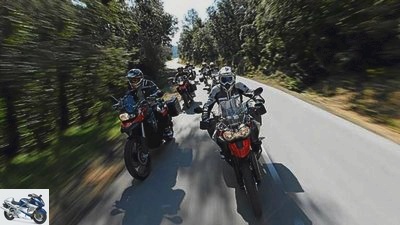
Photos: Jahn
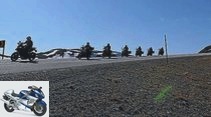
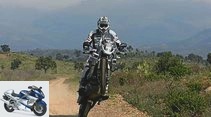
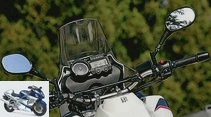
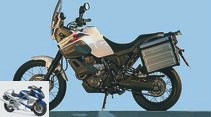
29 photos
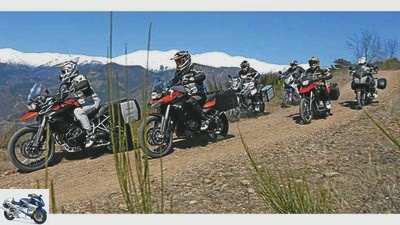
Jahn
1/29
Magnificent panorama of the Pyrenees peaks around the Col d’Ares.
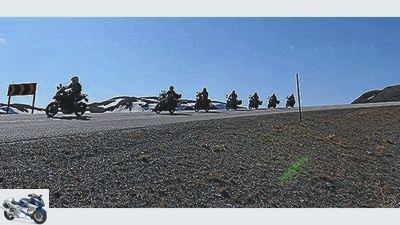
Jahn
2/29
Fantastic bikes, fantastic weather.
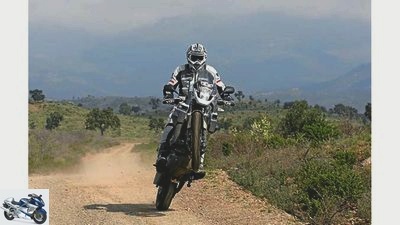
Jahn
3/29
Yamaha XT 660 Z Tenere – where are you going to Dakar? The look and feel of the Tenere (such as the towering cockpit) arouse rally fever.
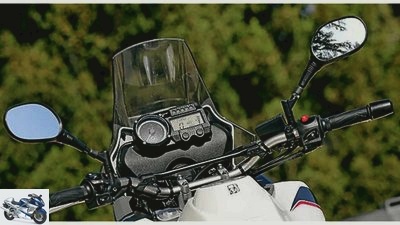
Jahn
4/29
Ultimately, the relatively tame and not very elastic engine cools the spark of enthusiasm at the Yamaha.
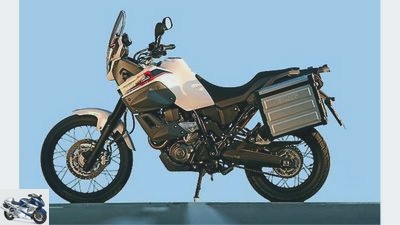
Jahn
5/29
The Yamaha XT 660 Z Tenere.
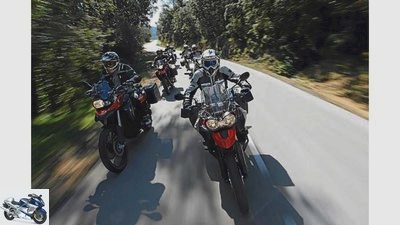
Jahn
6/29
Mid-range travel enduros are an interesting alternative to their large-capacity counterparts.
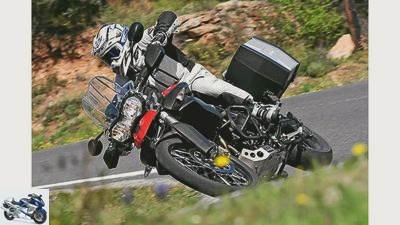
Jahn
7/29
Triumph Tiger 800 – What a debut: The little Tiger stalks straight ahead.
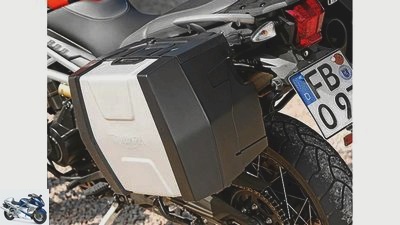
Jahn
8/29
A homogeneous, very neutrally tuned chassis, the elaborate equipment and especially the silky smooth engine convince the tourist-oriented clientele of the Triumph. The voluminous suitcases anyway.
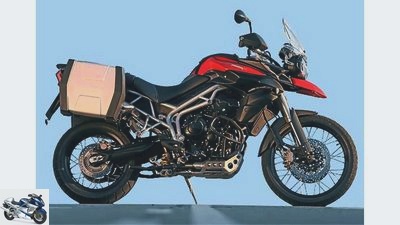
Jahn
9/29
The Triumph Tiger 800 XC.
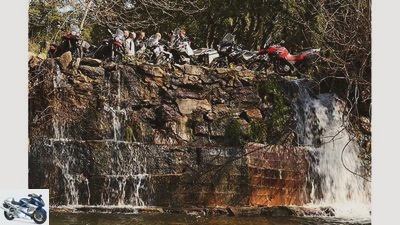
Jahn
10/29
Simply beautiful: many streams, few people – a cozy break on the edge of the Pyrenees.
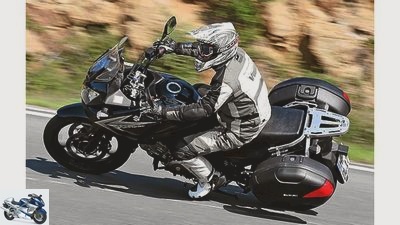
Jahn
11/29
Suzuki V-Strom – Hidden: One of the best mid-range travel enduros is hidden behind the voluminous shell (below).
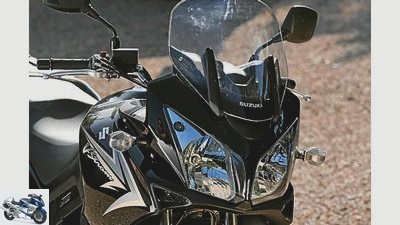
Jahn
12/29
Sensational engine, travel-friendly chassis, great wind protection – the only thing missing is the pep in the design of the Suzuki.
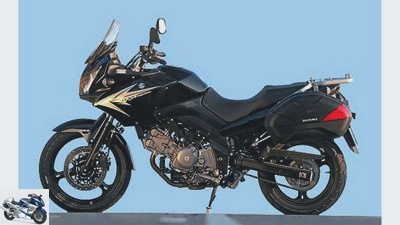
Jahn
13/29
The Suzuki V-Strom.
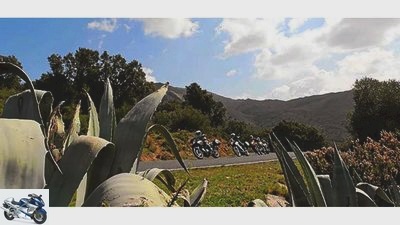
Jahn
14/29
. . . and that stings, stings, stings: agaves in the run-off zone at Col de Banyuls.
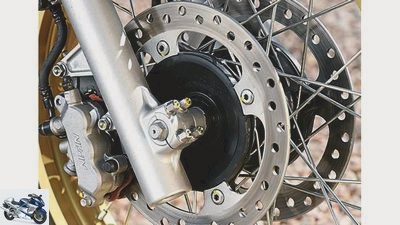
Jahn
15/29
Moderate dimensions and power from the low revs appeal to the Honda Transalp – the excellent front brake anyway.
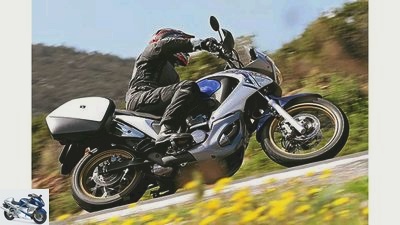
Jahn
16/29
The conspicuously inconspicuous: The Transalp traditionally relies on understatement.
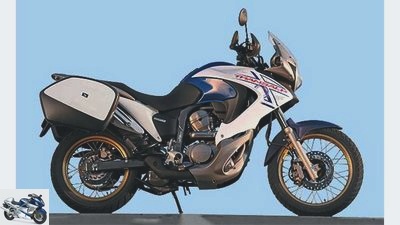
Jahn
17/29
The Honda Transalp.
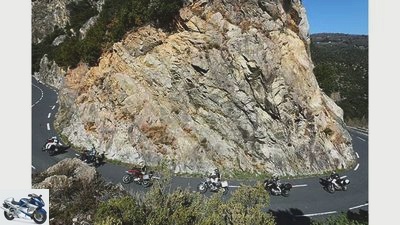
Jahn
18/29
Getting the hang of it: impressive road through the Tech Valley near Prats de Mollo.
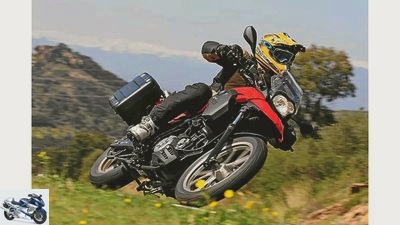
Jahn
19/29
BMW G 650 GS Revival: the cultivated single returns after a three-year break.
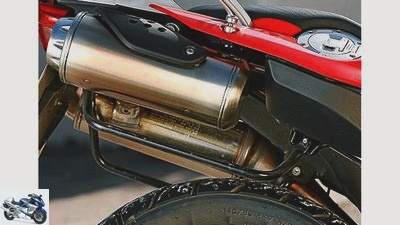
Jahn
20/29
BMW G 650 GS – unusual: the rear muffler only serves as an antechamber for the silencer in the foreground.
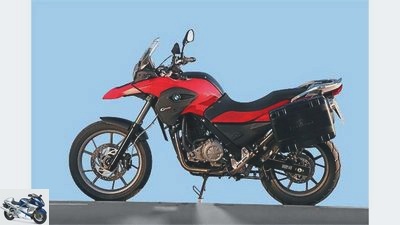
Jahn
21/29
The BMW G 650 GS.
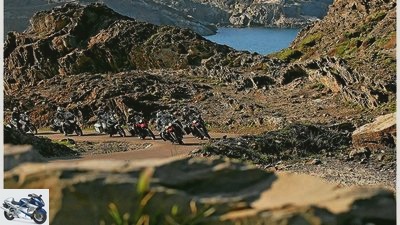
Jahn
22/29
Prelude: Bizarre rock formations at Cap de Creus – the easternmost point of Spain.
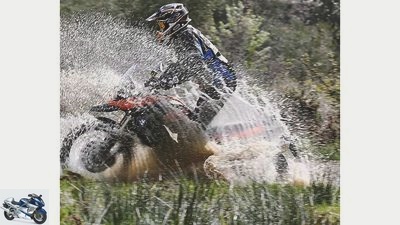
Jahn
23/29
Fun mobile: the BMW F 800 GS is the fun bike among middle-class children.
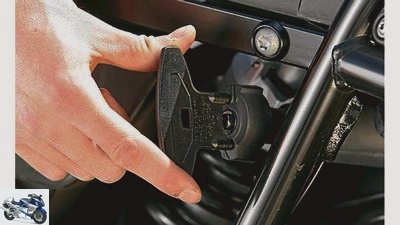
Jahn
24/29
Practical: tool for adjusting the spring base on the BMW F 800 GS.
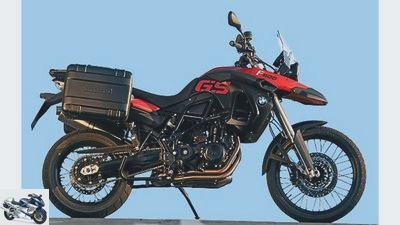
Jahn
25/29
The BMW F 800 GS.
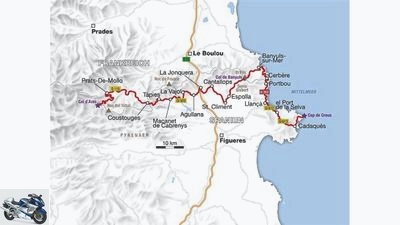
Jahn
26/29
Borderline experiences: The region between Spain and France offers huge driving fun in the smallest of spaces. The low-traffic mountain roads are a dream.
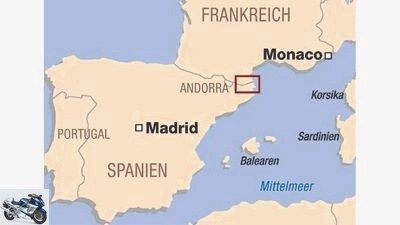
Jahn
27/29
The region between Spain and France on the map.
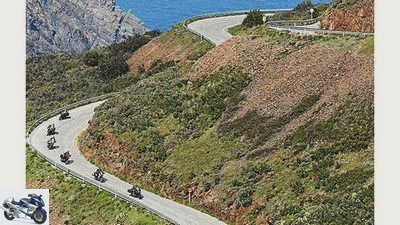
Jahn
28/29
Impressive streets with a great panorama.
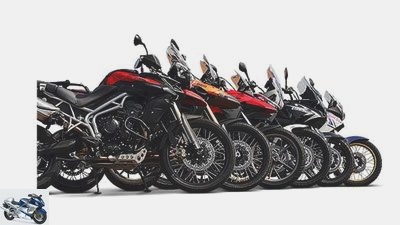
Jahn
29/29
In series: BMW F 800 GS, BMW G 650 GS, Honda Transalp, Suzuki V-Strom 650, Triumph Tiger 800 XC, Yamaha XT 660 Z Tenere.
Megatest Enduros 2011
The enduro mega test part 1: travel enduros up to 800 cm³
Last but not least, the new Triumph Tiger 800 XC proves that mid-range travel enduros are an interesting alternative to their large-displacement counterparts. In the Spanish-French border region, MOTORRAD is looking for top performers from the middle class.
Cap de Creus – only two curves and we have reached the most easterly point of Spain. The rocks jut out of the sea to the right and left of the narrow road. Torsten, our guide, knows the most spectacular places in the Spanish-French border region. The German has lived in the area for ten years and runs a rustic motorcycle hotel in the interior of the country (www.casa-holly.de).
D.he world in kilometer lapse. From sea level up to the mountains, over pass roads of all stripes, along straight connecting routes and including an off-road detour – the complete spectrum on a route length of just 170 kilometers. A perfect place to celebrate the premiere of the MOTORRAD travel enduro mega test. Its concept: divided into two categories (650 to 800 cm³ and over 1000 cm³), the current travel enduros fight for the respective class victory. Their winners then compete against each other in a final. In order to do justice to the definition of enduro, funbikes or their derivatives such as Kawasaki Versys or Ducati Multistrada, which are asphalt-oriented with 17-inch front wheels, are left out.
Buy complete article
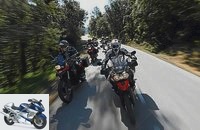
Megatest Enduros 2011
The enduro mega test part 1: travel enduros up to 800 cm³
F 800 GS and the brand new Triumph Tiger 800 XC. Two or three-cylinder in-line engines with around 90 hp, off-road optics with 21 or 17 inch spoked wheels, acceptable wind protection – these key data clearly signal the goal: universality. Travel, grass, gravel detours. A claim that also needs to be financed. Even if the equipment has been adjusted, the noble duo is still at least 2000 euros above the competition, as a full dresser with suitcases and extras they ultimately cost around 12,000 euros.
Jahn
In series: BMW F 800 GS, BMW G 650 GS, Honda Transalp, Suzuki V-Strom 650, Triumph Tiger 800 XC, Yamaha XT 660 Z Tenere.
The lighthouse at Cap de Creus is practically our starting point. We swing again along the narrow road from the cape towards Cadaques. Disoriented tourists in rental cars look at everything but not the traffic. We line up, resigned to fate, in the jerk. Well, at least there is enough attention left to feel the machines. Like the Yamaha. The steeply towering windshield, the high, wide handlebars and the narrow knees – all of this suggests a rally feeling. In comparison, the 650 BMW turns out like a minibike. At 825 millimeters, the lowest seat height of the sextet, the footrests placed relatively far forward and the cladding that appears rudimentary from the driver’s perspective make the GS (modified cladding, tank reduced from 16.5 to 14 liters) look delicate. Similar to the Honda Transalp. Since the major revision for the 2008 season, the Transe has been one size smaller. The second-lowest seat height (830 millimeters), the comparatively narrow handlebars and the footrests, which are also relatively far forward, ensure comfort – albeit a bit cramped. Which is topped by the Suzuki. The V-Strom is the grande dame of mid-range travel enduro bikes, voluminous and lush.
Although it sits a bit decoupled, it is extremely relaxed and offers excellent protection from the wind behind the wide cladding. It’s not enduro, but it’s comfortable. Enduro? The BMW F 800 GS was just waiting for this keyword. Narrow seat, slim waist, high handlebar position – Offroader immediately wraps the 800 with this ergonomics around his finger. And not just that. The seating furniture is cuddly upholstered, the knee angle – as a concomitant feature of the second largest seat height in the group of six at 880 millimeters – unusually open. Like that. Just like the command center on the Triumph. Even if their workplace does not adopt BMW’s sporting orientation. The seating position moves the pilot a little further back, the handlebars stretch more towards him, the wind protection is a shade more pronounced. In direct comparison to the BMW, the Briton relies less on sport and more on touring. Especially since the Triumph has gained an impressive twelve kilograms compared to the comparison test with the BMW F 800 GS, which at that time weighed 225 kilograms, with ABS, pannier rack, adjustable windshield and main stand.
The tourist caravan is finally saying goodbye in Cadaques, an idyllic artist village and former summer residence of the surrealist painter Salvador Dalí, who was born in nearby Figueres. We are heading northwest. Torsten didn’t promise us too much. Straight lines? Nothing. Both on the rocky ridge of the Cap de Creus and later along the ascending and descending coastal road to Banyuls-sur-Mer in France.
Jahn
Borderline experiences: The region between Spain and France offers huge driving fun in the smallest of spaces. The low-traffic mountain roads are a dream.
What counts here are above all handling and weight. Right, left, right. It is not illogical that the smallest and lightest of the six, the BMW G 650 GS, at 198 kilograms, sets the pace here. More likely that the 225 kilo Suzuki is on her heels. The V-Strom turns completely unspectacularly, holds every line fantastically securely, and cannot be impressed by anything or anyone. Such a convincing appearance would not have been expected of the reserved lady. One begins to understand why Suzi won two overall victories in a row (2005 and 2006) at the MOTORRAD Alpine Master in her younger years. The Triumph (237 kilos) has a similar format. The Englishwoman swings through the curves cool and confident with typically British understatement. With a decidedly neutral driving behavior, it keeps the pilot away from stress, but does not allow itself to be bent as readily as, for example, the Transalp (230 kilos). The 800 BMW (225 kilos) works differently. She literally craves the inside line, makes corrections to the chosen lane child’s play, but always remains a tad more nervous in the winding curve. By the way: For better comparability, MOTORRAD tires the F 800 GS and the Tiger with Bridgestone Battle Wing 501/502 identical. The basically also handy Tenere (215 kilos) forfeits some sympathy here due to its spongy steering precision.
In the center of Banyuls-sur-Mer, an inconspicuous lane branches off to the left to the Col de Banyuls. During the Spanish Civil War, thousands of persecuted Catalans fled to France over this pass, which is only 361 meters high. Today the transition is almost deserted – and in poor condition. The road winds its way up, bumpy and dirty. Actually, as if made for enduro bikes.
Enduro? Once again, the BMW jumps at this key word, rumbling unabashedly from pothole to pothole with its comfortably tuned suspension. Thoughts of the cardan drive of the 1200 GS, which hit badly in such situations, are quickly suppressed. Only a little mental slap on the shoulder for the F 800 GS and Co. remains: This middle class has something. Because the rest of the group also dart playfully between asphalt faults, loose boulders and hairpin bends upwards. And again it is the Suzuki that, after the BMW, is the easiest to handle the bumpy game, but this time has to share its pursuit position with the likewise comfortably tuned Yamaha. The Triumph acts tighter. However, the 800 XC makes up for the somewhat lower comfort with greater suspension reserves. A noticeable advantage when loading or in two-person operation. A topic that remains of secondary importance with the softly tuned G 650 GS. And the Transalp? Although it impresses with its extremely sensitive front fork, the shock absorber remains overdamped despite the latest revision and cannot quite hold a candle to the rest of the group in terms of comfort.
The asphalt improves on the last few meters of the pass. We glide lively back to Spain. The terrain becomes flatter, the curves open up, the view sweeps over the Baix Empordà, as the extensive plain before the rise of the Pyrenees is called here. And it stays curvy. Even when we are almost at sea level, well-paved roads wind like worms between fields, streams and forests.
We seize the opportunity, make an unscheduled turn to a military training area. Wide slopes and barren vegetation let us rob the route in the spirit of the Dakar. The Transalp and V-Strom set very tight limits to the endurance sporting spirit in the gravel, which the G 650 GS only shifts carefully due to its lower weight. More than contemplative enduro hiking makes no sense with this trio. And even the Triumph is cautious despite its off-road appearance. The wide knee joint and the massive engine make the XC a bit sluggish off-road. In contrast to the BMW and Yamaha. Steep and muddled climbs, water crossings – the duo plow themselves through challenging terrain. Ultimately, the engine makes the difference. With the finely adjustable twin, the BMW driver maneuvers through terrain much more safely and with greater traction than with the Tenere drive, which hackles at low speeds.
Jahn
Fun mobile: The F 800 is the fun bike among middle graders.
We dust off our clothes. The driveway from Agullana up to the 550 meter high mountain village of La Vajol tops the off-road excursion in any case, the narrow and tricky descent even more. Every third curve becomes a brake test. All bikes have ABS. The Honda (in the tested Comfort version) and Suzuki as standard, the rest at a price of between 400 and 710 euros. Also for the Triumph, for which an anti-lock device was not yet available for the said first duel with the BMW. And so much first: The set-up was successful, the fine control behavior catapulted the Triumph ABS into the premier league straight away.
However, emergency braking remains the exception. In daily life and also here on the tour, it is all about hand strength, controllability and braking effect. And that’s where the Triumph arrangement of the Transalp and the 800 BMW can be slowed down. Compared to the sharp and yet easily controllable retarders of this duo, the Triumph lags a bit. The pressure point is less defined, the necessary hand strength is higher. Just like the system of the V-Strom, which in turn can just prevail against the slightly more spongy brakes of the Yamaha. Ultimately, only the single-disc system of the G 650 GS falls out of the high level of the test team.
With red-hot brake discs, after umpteen downward turns, we hit the wide feeder road in the direction of Tapies. It is making good progress. The faster it gets, the more the Triumph comes to the fore. What an engine! Whether right at the bottom (from 1500 rpm!), In the middle or at high speeds, these treble hooks always grip. And it does it silky smooth, almost vibration-free and with that typical throaty sound. An experience in a class of its own. Even the lively parallel twin of the 800-series BMW, with almost identical performance, does not come up against it. Especially since it vibrates strongly in the higher speed range. In this respect the V-Strom is exemplary. The 90-degree V2 pulls cleanly out of the rev range, purrs extremely smoothly through the rev range. A magnificent engine that ultimately only lacks one thing for the top duo: 20 hp. Similar to the Honda propellant. But it sets its priorities in the lower and medium speed range. There the 52-degree Vau engine grabs a lot, runs smoothly and encourages you to shift up early. Adds another piece of the mosaic to the almost conspicuously inconspicuous overall concept of the Transalp. What remains is the single-cylinder fraction. Naturally a concept with less smooth running and less performance, but also with less weight, less installation space and less technical effort. Ultimately a question of conviction. To which the BMW engine knows the better answer. Especially when it comes to running smoothness, the single made by Loncin in China is superior to the Yamaha counterpart. While the China cracker runs smoothly even at low speeds and can be squeezed out up to the speed limit of 7500 rpm, the Tenere single-cylinder rattles audibly up to 3000 rpm, then pushes forward decently, but flattens out again at almost 6000 tours. This means that the Yamaha delivers the leanest performance in the test.
But also a moderate consumption. Even if the 4.2 liters are still just under a liter higher than the currently most frugal motorcycle of all, the G 650 GS with a sensational 3.4 liters. Even the comparatively high fuel consumption of the Triumph in this environment remains at an overall acceptable level of 4.9 liters.
Jahn
. . . and that stings, stings, stings: agaves in the run-off zone at Col de Banyuls.
Shortly before Coustouges the surface changes in the middle of the curve, suddenly turning the road into a bumpy track. A clear indication that we are back in France. But maybe we should be grateful to the Gauls for these perfectly developed Spanish roads. After all, France is the third largest contributor to the EU and Spain the third largest recipient.
The Triumph and the 800 BMW have long since lost the rest of the quartet from the rear-view mirrors, and after the approach to Prats de Mollo – almost in the final spurt – they wag up the Col dAres.
The situation is symbolic. While the BMW G 650 GS is likely to find its fans among the ranks of those returning to the sport or those interested in a second motorcycle and the Yamaha appeals to single fans with an affinity for off-roading, the Honda and Suzuki are going more conventional ways. If you can do without glamor, you will find two rock-solid all-rounders at a fair price. But one thing is clear: The BMW and the Triumph dominate the field of mid-range travel enduros without restriction. Each in its own individual way. While the conceptually broad-based F 800 GS appeals with sportiness in all areas, the more tourist-oriented Triumph counters with a finesse and suitability for travel that has not yet been achieved in this category, snatching the Bavarian class victory with a wafer-thin margin. The grand finale in could well be interesting.
MOTORCYCLE scoring
Jahn
BMW G 650 GS Revival: the cultivated single returns after a three-year break.
engine
The Triumph’s smoothness and power output are first class, as is the performance. With the latter, the Tiger can only stand up to the BMW F 800 GS. The engine of the Suzuki V-Strom is also brilliant. Smooth running and revving are at the highest level, only in top performance the 650er lacks around 20 hp on the leading duo. With less revving – and less power – the V2 of the Transalp falls off against the Suzuki. The single-cylinder must naturally be modest in terms of smoothness. The Tenere also delivers the worst performance of the sextet.
Winner engine: triumph
landing gear
Despite their fundamentally different orientations, the 800 series BMW and the Suzuki V-Strom share the space in the sun. The Bavarian impresses with good handling and excellent suspension, the Japanese with extremely confident, neutral steering behavior. The Triumph, whose strength lies in its pronounced cornering stability, follows just a blink of an eye away. Only the lean angle limited early on by the side stand costs the 650 BMW points – just like the limited adjustable spring elements of the Honda and Yamaha bring trigger.
Chassis winner: BMW F 800 GS / Suzuki
everyday life
With good light and, above all, lavish equipment (adjustable seat height, on-board computer), the Triumph dominates the everyday rating. The 800 BMW counteracts it with relaxed ergonomics. In terms of points, the Suzuki, with the best wind protection in the test field and a range of over 500 kilometers, remains close to the Bavarian. It is precisely these two aspects that help the Tenere to gain a cushion of points. Above all, the moderate weight (handling) enables the 650 BMW to join forces with the Transalp.
Winner everyday: triumph
security
First-class brakes and a sensitive ABS control bring the Transalp the group victory, just ahead of the very efficiently decelerating 800 BMW. Behind the V-Strom, the Tiger only ranks in the middle of the field despite the new ABS. The ABS of the Tenere could regulate a little more sensitively, while the single-disc brake of the G 650 is not on a par with the competition.
Safety winner: Honda
costs
Its sensationally low consumption (3.4 liters / 100 km) brings the G 650 GS to victory. The Transalp comes in last – mainly because of the short inspection intervals (6000 kilometers).
Winner costs: BMW G 650 GS
| Max. score |
BMW G 650 GS |
BMW F 800 GS |
Honda | Suzuki | triumph | Yamaha | Overall rating | 1000 | 600 | 660 | 603 | 637 | 661 | 577 | Placement | 5. | 2. | 4th. | 3. | 1. | 6th. | Price-performance note | 1.0 | 1.7 | 1.8 | 1.9 | 1.3 | 1.7 | 2.1 |
Price-performance
If a motorcycle deserves victory, it is the V-Strom. A good motorcycle at a fair price.
Price-performance winner: Suzuki
MOTORCYCLE test result
Jahn
Triumph Tiger 800 – What a debut: The little Tiger stalks straight ahead.
1. Triumph Tiger 800 XC
Fantastic engine, homogeneous chassis and now ABS. The Tiger beats the BMW – if only by a hair’s breadth.
2. BMW F 800 GS
Second place, what the heck? When it comes to driving fun, the BMW does not show anything. The lively engine, the agile chassis and universal alignment prove: travel enduro is also possible with 800 cm³.
3. Suzuki V-Strom 650
Years ago she won the MOTORRAD Alpine Masters. The trump cards of the inconspicuous Suzuki – brilliant engine and balanced chassis – still stand out today.
4. Honda Transalp
The Transalp is still an attractive bike with good running culture and good-natured handling. But the former middle-class legend is increasingly feeling the pressure of the competition.
5. BMW G 650 GS
With the smallest GS, BMW cannot stand up to the multi-cylinder top dogs. The single builds on moderate weight, great handling and moderate price.
6. Yamaha XT 660 Z
Tenere The expectations that the sporty look of the Tenere arouses cannot be fully met by the 660. The somewhat sluggish single-cylinder engine urgently needs modernization.
Technical specifications
Jahn
At the destination: a wonderful panorama of the Pyrenees peaks around the Col d’Ares.
BMW G 650 GS
| engine | design type | Single cylinder engine |
| injection | Ø 43 mm | coupling | Multi-disc oil bath clutch |
| Bore x stroke | 100.0 x 83.0 mm | Displacement | 652 cm3 |
| compression | 11.5: 1 | power | 35.0 kW (48 hp) at 6500 rpm |
| Torque | 60 Nm at 5000 rpm | landing gear |
| frame | Bridge frame made of steel | fork | Telescopic fork, Ø 41 mm |
| Brakes v / h | Ø 300 / Ø 240 mm | Assistance systems | SECTION |
| bikes | 2.50 x 19; 3.50 x 17 | tires | 110/80 R 19; 140/80 R 17 |
| Tires | Metzeler Tourance EXP, vo. “B” | mass and weight |
| wheelbase | 1477 mm | Steering head angle | 61.9 degrees |
| trailing | 113 mm | Suspension travel v / h | 170/165 mm |
| Seat height 1 | 825 mm | Case width 1 | 840 mm |
| Weight case 1 | 9.3 kg | Weight with full tank 1 | 198 kg |
| Payload 1 | 182 kg | Tank capacity / reserve | 14.0 liters |
| Service intervals | 10000 km | price | 6900 euros |
| Price test motorcycle | 8200 Euro² | Additional costs | 264 euros | MOTORCYCLE readings | Top speed * | 170 km / h |
| acceleration | 0-100 km / h | 5.1 sec |
| 0-140 km / h | 11.3 sec | Pulling speed 60–140 km / h | 5.7 sec |
| 100-140 km / h | 7.5 sec | 140-180 km / h | consumption | Consumption highway | 3.4 liters / normal |
| Reach country road | 412 km |
BMW F 800 GS
| engine | design type | Two-cylinder in-line engine |
| injection | Ø 46 mm | coupling | Multi-disc oil bath clutch |
| Bore x stroke | 82.0 x 75.6 mm | Displacement | 798 cm3 |
| compression | 12.0: 1 | power | 62.5 kW (85 PS) at 7500 rpm |
| Torque | 83 Nm at 5750 rpm | landing gear |
| frame | Steel tubular frame | fork | Upside-down fork, Ø 45 mm |
| Brakes v / h | Ø 300 / Ø 265 mm | Assistance systems | SECTION |
| bikes | 2.15 x 21; 4.25 x 17 | tires | 90 / 90-21; 150/70 R 17 |
| Tires | Bridgestone BattleWing 501/502 “G” | mass and weight |
| wheelbase | 1578 mm | Steering head angle | 64.0 degrees |
| trailing | 117 mm | Suspension travel v / h | 230/215 mm |
| Seat height 1 | 880 mm | Case width 1 | 1030/930 mm |
| Weight case 1 | 12.1 kg | Weight with full tank 1 | 225 kg |
| Payload 1 | 218 kg | Tank capacity / reserve | 16.0 liters |
| Service intervals | 10000 km | price | 10150 euros |
| Price test motorcycle | 12120 euros³ | Additional costs | 269 euros | MOTORCYCLE readings | Top speed * | 204 km / h |
| acceleration | 0-100 km / h | 4.0 sec |
| 0-140 km / h | 7.1 sec | Pulling speed 60–140 km / h | 4.4 sec |
| 100-140 km / h | 5.2 sec | 140-180 km / h | 8.9 sec | consumption | Consumption highway | 4.2 liters / super |
| Reach country road | 381 km |
Honda Transalp
| engine | design type | Two cylinder 52 degree V engine |
| injection | Ø 40 mm | coupling | Multi-disc oil bath clutch |
| Bore x stroke | 81.0 x 66.0 mm | Displacement | 680 cm3 |
| compression | 10: 1 | power | 44.1 kW (60 hp) at 7750 rpm |
| Torque | 60 Nm at 6000 rpm | landing gear |
| frame | Single-loop frame made of steel | fork | Telescopic fork, Ø 41 mm |
| Brakes v / h | Ø 256 / Ø 240 mm | Assistance systems | SECTION |
| bikes | 2.15 x 19; 3.50 x 17 | tires | 100/90 19; 130/80 17 |
| Tires | Bridgestone TrailWing 101/152 | mass and weight |
| wheelbase | 1515 mm | Steering head angle | 61.9 degrees |
| trailing | 106 mm | Suspension travel v / h | 177/173 mm |
| Seat height 1 | 830 mm | Case width 1 | 890 mm |
| Weight case 1 | 7.6 kg | Weight with full tank 1 | 230 kg |
| Payload 1 | 189 kg | Tank capacity / reserve | 17.0 liters |
| Service intervals | 6000 km | price | 8390 euros |
| Price test motorcycle | 9,553 euros 4 | Additional costs | 170 euros | MOTORCYCLE readings | Top speed * | 172 km / h |
| acceleration | 0-100 km / h | 5.1 sec |
| 0-140 km / h | 10.0 sec | Pulling speed 60–140 km / h | 5.6 sec |
| 100-140 km / h | 6.8 sec | 140-180 km / h | consumption | Consumption highway | 4.7 liters / normal |
| Reach country road | 362 km |
Suzuki V-Strom 650
| engine | design type | Two cylinder 90 degree V engine |
| injection | Ø 39 mm | coupling | Multi-disc oil bath clutch |
| Bore x stroke | 81.0 x 62.6 mm | Displacement | 645 cm3 |
| compression | 11.5: 1 | power | 49.0 kW (67 hp) at 8800 rpm |
| Torque | 60 Nm at 6400 rpm | landing gear |
| frame | Bridge frame made of aluminum | fork | Telescopic fork, Ø 43 mm |
| Brakes v / h | Ø 310 / Ø 260 mm | Assistance systems | SECTION |
| bikes | 2.50 x 19; 4.00 x 17 | tires | 110 / 80-19; 150 / 70-17 |
| Tires | Bridgestone Trail Wing 101/152 vo. “J”, hi. “F” | mass and weight |
| wheelbase | 1540 mm | Steering head angle | 64.0 degrees |
| trailing | 110 mm | Suspension travel v / h | 150/150 mm |
| Seat height 1 | 840 mm | Case width 1 | 1050 mm |
| Weight case 1 | 7.9 kg | Weight with full tank 1 | 225 kg |
| Payload 1 | 194 kg | Tank capacity / reserve | 22.0 liters |
| Service intervals | 6000 km | price | 8090 euros |
| Price test motorcycle | 8,526 euros 5 | Additional costs | 135 euros | MOTORCYCLE readings | Top speed * | 180 km / h |
| acceleration | 0-100 km / h | 4.5 sec |
| 0-140 km / h | 9.0 sec | Pulling speed 60–140 km / h | 5.8 sec |
| 100-140 km / h | 8.2 sec | 140-180 km / h | consumption | Consumption highway | 3.9 liters / normal |
| Reach country road | 564 km |
Triumph Tiger 800 XC
| engine | design type | Three-cylinder in-line engine |
| injection | Ø 44 mm | coupling | Multi-disc oil bath clutch |
| Bore x stroke | 74.0 x 61.9 mm | Displacement | 799 cm3 |
| compression | 11.1: 1 | power | 70.0 kW (95 PS) at 9300 rpm |
| Torque | 79 Nm at 7850 rpm | landing gear |
| frame | Steel tubular frame | fork | Upside-down fork, Ø 45 mm |
| Brakes v / h | Ø 308 / Ø 255 mm | Assistance systems | SECTION |
| bikes | 2.50 x 21; 4.25 x 17 | tires | 90 / 90-21; 150 / 70-17 |
| Tires | Bridgestone BattleWing 501/502 “G” | mass and weight |
| wheelbase | 1568 mm | Steering head angle | 66.9 degrees |
| trailing | 91 mm | Suspension travel v / h | 220/215 mm |
| Seat height 1 | 855/875 mm | Case width 1 | 1010 mm |
| Weight case 1 | 14.6 kg | Weight with full tank 1 | 237 kg |
| Payload 1 | 201 kg | Tank capacity / reserve | 19.0 liters |
| Service intervals | 10000 km | price | 9590 euros |
| Price test motorcycle | 11962 euros 6 | Additional costs | 350 Euro | MOTORCYCLE readings | Top speed * | 210 km / h |
| acceleration | 0-100 km / h | 4.0 sec |
| 0-140 km / h | 7.0 sec | Pulling speed 60–140 km / h | 4.1 sec |
| 100-140 km / h | 5.1 sec | 140-180 km / h | 8.7 sec | consumption | Consumption highway | 4.9 liters / super |
| Reach country road | 388 km |
Yamaha XT 660 Z Tenere
| engine | design type | Single cylinder engine |
| injection | Ø 50 mm | coupling | Multi-disc oil bath clutch |
| Bore x stroke | 100.0 x 84.0 mm | Displacement | 660 cm3 |
| compression | 10.0: 1 | power | 35.3 kW (48 hp) at 6000 rpm |
| Torque | 58 Nm at 5500 rpm | landing gear |
| frame | Single-loop frame made of steel | fork | Telescopic fork, Ø 43 mm |
| Brakes v / h | Ø 298 / Ø 245 mm | Assistance systems | SECTION |
| bikes | 1.85 x 21; 2.75 x 17 | tires | 90 / 90-21; 130 / 80-17 |
| Tires | Pirelli Scorpion Trail | mass and weight |
| wheelbase | 1500 mm | Steering head angle | 62.0 degrees |
| trailing | 113 mm | Suspension travel v / h | 210/200 mm |
| Seat height 1 | 910 mm | Case width 1 | 850 mm |
| Weight case 1 | 10.4 kg | Weight with full tank 1 | 215 kg |
| Payload 1 | 221 kg | Tank capacity / reserve | 23.0 liters |
| Service intervals | 10000 km | price | 7595 euros |
| Price test motorcycle | 8919 euros 7 | Additional costs | 165 euros | MOTORCYCLE readings | Top speed * | 160 km / h |
| acceleration | 0-100 km / h | 5.9 sec |
| 0-140 km / h | 12.4 sec | Pulling speed 60–140 km / h | 6.2 sec |
| 100-140 km / h | 8.5 sec | 140-180 km / h | consumption | Consumption highway | 4.2 liters / normal |
| Reach country road | 548 km |
* Manufacturer information; 1 MOTORCYCLE measurements; 2 including ABS (400 euros), case system (585 euros), main stand (120 euros) and heated grips (195 euros); 3 including ABS (710 euros), case system (715 euros), luggage rack (85 euros), main stand (120 euros), on-board computer (145 euros) and heated grips (195 euros); 4 incl. Case system (703 euros), main stand (291 euros), heated grips (169 euros); 5 including case system
(436 euros); 6 including ABS (600 euros), case system (739 euros), adjustable clutch lever (33 euros), adjustable touring disc (214 euros), aluminum engine guard (169 euros), engine protection bar (219 euros), main stand (199 euros) and heated grips (199 euros); 7 including ABS (400 euros) and case system (924 euros)
Performance chart
archive
The performance diagram of the enduro bikes.
The group of six is divided not only technically but also in terms of performance into three categories. While the single-cylinder duo (BMW G 650 GS, Yamaha Tenere) with around 50 hp is very close to each other in terms of peak performance, the BMW single is more sociable in practice. The Chinese-Bavarian co-production impresses with better running smoothness at low speeds and, above all, a more potent upper speed quarter (see performance curve). The case is similar with the two 650 series Vau engines of the Honda Transalp and the Suzuki V-Strom. Due to its greater revving, the Suzuki propellant not only generates more power, but also acts much more lively in the wild. The character differences between the three-cylinder Triumph Tiger and the parallel twin of the BMW F 800 GS are also reflected in the diagram. If the BMW engine impresses with its superior torque and quick response, the linear power output and the – non-measurable – smoothness of running are among the good things about the Triumph three-cylinder.
Equipment / prices
Jahn
A homogeneous, very neutrally tuned chassis, the elaborate equipment and especially the silky smooth engine convince the tourist-oriented clientele of the Triumph. The voluminous suitcases anyway.
| BMW G 650 GS | BMW F 800 GS | Honda | SECTION | 400 euros | 710 euros | • |
| Case system | 585 euros | from 715 euros | from 703 euros | Capacity per case (left / right) | 28/28 liters | 29/38 liters | 29/29 liters |
| Inner pockets case (set) | 170 euros | 170 euros | 85 euros | Topcase / |
| Capacity | 310 euros / 31 liters | 385 euros / 35 liters | from 387 euros / 45 liters * | Inner topcase pocket | 70 euros | 85 euros | 55 euros |
| Hand protectors | 80 euro | 25/40 euros | • | Luggage rack | • | 60/85 euros | • |
| Luggage hook | • | • | • | Adjustable seat height | – | – | – |
| Adjustable handlebar position | – | – | – | Width-adjustable brake / clutch levers | – / • | • / • | • / – |
| Touring screen | 160 euros | 295 euros | 138 euros * | Aluminum engine protection | 115 euros | 210 euros | – |
| Engine protection bar | 130 euros | 275 euros | – | Main stand | 120 euros | 120 euros | 291 euros * |
| Second trip odometer | • | • | • | Board computer | – | – |
| Consumption display | – | – | Fuel gauge | – | 145 euros | • |
| Gear indicator | – | • | Tire pressure control display | – | – | – |
| Oil level indicator | Sight glass | Sight glass | Dipstick | Ambient temperature display | – | • | – |
| Heated grips | 195 euros | 195 euros | (from 169 euros) * | Board socket | 20 Euros | • | 91 euros |
| Time clock | • | • | • | Immobilizer | – | • | • |
| Anti-theft alarm system | 207 euros | 207 euros | 320 euros |
| Suzuki | triumph | Yamaha | SECTION | • | 600 euros | 400 euros |
| Case system | from 436 euros | 739 euros | 924 euros | Capacity per case (left / right) | 35/32 liters | 37/25 liters | 30/30 liters |
| Inner pockets case (set) | 73 euros | 119 euros | 71 euros | Topcase / |
| Capacity | from 250 euros / 48 liters | 518 euros / 35 liters | 378 euros / 30 liters | Inner topcase pocket | 40 euros | 79 euros | 50 Euros |
| Hand protectors | 60 euro | • | 45 euros | Luggage rack | • | • | • |
| Luggage hook | • | • | • | Adjustable seat height | – | 2-stage | – |
| Adjustable handlebar position | – | • | – | Width-adjustable brake / clutch levers | • / – | • / 33 euros | • / – |
| Touring screen | 130 euros | 214 euros | – | Aluminum engine protection | 240 euros | 169 euros | 138 euros |
| Engine protection bar | 120 euros | 219 euros | – | Main stand | 230 euros | 199 euros | 157 euros |
| Second trip odometer | • | • | • | Board computer | – | • | – |
| Consumption display | – | • | – | Fuel gauge | • | • | • |
| Gear indicator | – | • | – | Tire pressure control display | – | 169 euros | – |
| Oil level indicator | Dipstick | Dipstick | Dipstick | Ambient temperature display | – | – | – |
| Heated grips | 300 Euro | 199 euros | – | Board socket | 33 euros | • | – |
| Time clock | • | • | • | Immobilizer | • | • | • |
| Anti-theft alarm system | 130 euros | 399 euros | – |
• standard equipment; * included in the comfort package for 700 euros
Used middle class travel enduro bikes in Germany
1000PS marketplace app
Mid-range travel enduros are a popular segment on the used market.
The mid-range travel enduro segment is very popular on the used market. The selection is large and the prices very attractive, and most used vehicles are already equipped with the most important travel accessories, such as luggage sets. You can find an overview of the motorcycle market here: used mid-range travel enduros in Germany.
Related articles
-
Suzuki, Honda and BMW travel enduros put to the test
Fisherman 23 photos faceCatcher.com 1/23 Mid-range travel enduros from Suzuki, Honda and BMW in a comparison test. faceCatcher.com 2/23 Procedure? No, U…
-
The enduro mega test: travel enduros up to 1200 cm³
44 pictures 1/44 The final opponent of BMW, the Triumph Tiger 800 XC. 2/44 Wide handlebars, fat motors, big …
-
Comparison test of travel enduros
Jahn comparison test of travel enduros, BMW F 650 GS, Honda Transalp, Kawasaki Versys 650, Suzuki V-Strom 650 / XT We are then away towpath instead …
-
The super sports mega test part 1: Country road
Kuenstle 82 pictures Kuenstle 1/82 Easy to use traction control of the Aprilia. Kuenstle 2/82 A thoroughbred racing file with incredible handling ….
-
Big travel enduros put to the test at the 2014 Alpine Masters
Photo: fact / Joachim Schahl 13 photos fact / Joachim Schahl 1/13 The travel enduros Suzuki V-Strom 1000, KTM 1190 Adventure, Triumph Tiger Sport, Yamaha…
-
Comparison test travel enduro: Sweden to the North Cape
Jahn 28 pictures Jahn 1/28 The operation of the Multistrada has also changed: A control center for electronics and motor directly on the handlebar. Jahn 2/28 …
-
Five mid-range travel enduros (2019) in a comparison test
Theme special Everything about BMW Motorrad Tyson Jopson, Stefan Kaschel, Arturo Rivas 29 photos Tyson Jopson, Stefan Kaschel, Arturo Rivas 1/29 We have…
-
Comparison test travel enduro fun bike
Comparative test travel enduro / fun bike Biedermann and arsonist After the Suzuki V-Strom 650 A, the Kawasaki Versys now also sets fire in the nest of …
-
Gargolov comparison test travel enduro bikes: Aprilia ETV 1000 Caponord, BMW R 1150 GS, Honda Varadero 1000, Suzuki DL 1000 V-Strom, Triumph Tiger 955i …
-
Yamaha XT 1200 Z Super Tenere: Enduro travel enduro in the long-term test
Image: Bilski 20 Images 1/20 The Yamaha XT 1200 Z Super Tenere doesn’t care about the goals: whether for camping in the Allgau, in a North German hotel or for …